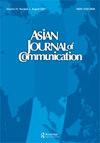宝莱坞电影中的伊斯兰重构——印度电影中伊斯兰身份建构研究
IF 1.5
2区 文学
Q2 COMMUNICATION
引用次数: 0
摘要
摘要本文考察了在印度民族主义和印巴分治历史背景下,刻板印象如何促进穆斯林身份叙事的构建。这项研究的主要焦点是主流电影如何描绘分治的历史和民族主义斗争,穆斯林身份是通过一系列交流媒介塑造和分享的。言语、身体、仪式和虚拟的交流方式在身份的构建和表现中发挥着重要作用。通过分析印度主流电影,本文探讨了印度穆斯林的表达如何与印度民族主义的概念及其分裂和边境政治的暴力历史联系在一起,在这些历史中,对伊斯兰教和穆斯林身份的刻板印象有助于舆论的形成。它认为,每当印度穆斯林的物质性通过这种形式表达出来时,他们就会被纳入现有的历史地理叙事,被虚构为理想的刻板印象,被规范化以适应特定的政治或意识形态观点,并最终固化为一组两极分化的集体身份。本文章由计算机程序翻译,如有差异,请以英文原文为准。
Reframing Islam in bollywood cinema: a study on the construction of the Islamic identity in Indian cinema
ABSTRACT
This paper examines how stereotypical perceptions contribute to the construction of Muslim identity narratives in the context of Indian nationalism and the history of the Indo-Pak Partition. The main focus of this study is on how mainstream cinema portrayed the historical and nationalistic struggles of Partition through which the Muslim identity was shaped and shared through a range of communicative mediums. The verbal, physical, ritualistic and virtual modes of communication play significant roles in the construction and performance of identity. Analyzing films of mainstream Indian cinema, this article explores how expressions of the Indian Muslim are associated with the concept of Indian nationalism and its violent history of Partition and border politics where the stereotypical perceptions of Islam and Muslim identity contribute to the shaping of public opinion. It argues that whenever the corporeality of Indian Muslims is expressed through such forms, they get incorporated into the existing historic-geographical narratives, fictionalized as ideal stereotypes, normalized to fit into a particular political or ideological view, and finally get solidified into a set of polarized collective identities.
求助全文
通过发布文献求助,成功后即可免费获取论文全文。
去求助
来源期刊

Asian Journal of Communication
COMMUNICATION-
CiteScore
3.70
自引率
0.00%
发文量
38
期刊介绍:
Launched in 1990, Asian Journal of Communication (AJC) is a refereed international publication that provides a venue for high-quality communication scholarship with an Asian focus and perspectives from the region. We aim to highlight research on the systems and processes of communication in the Asia-Pacific region and among Asian communities around the world to a wide international audience. It publishes articles that report empirical studies, develop communication theory, and enhance research methodology. AJC is accepted by and listed in the Social Science Citation Index (SSCI) published by Clarivate Analytics. The journal is housed editorially at the Wee Kim Wee School of Communication and Information at Nanyang Technological University in Singapore, jointly with the Asian Media Information and Communication Centre (AMIC).
 求助内容:
求助内容: 应助结果提醒方式:
应助结果提醒方式:


